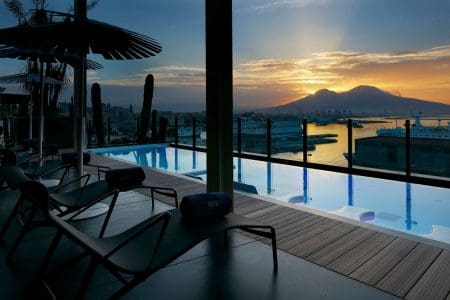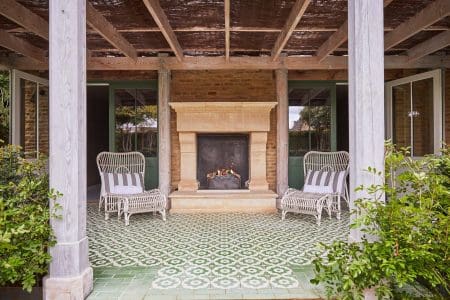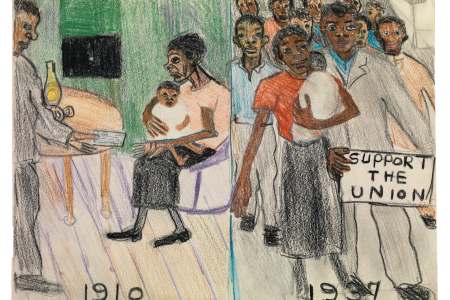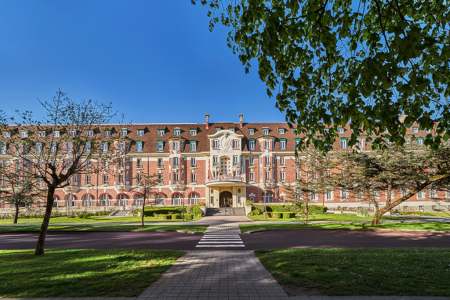Roger Hermiston and Eileen Wise visit Buckingham Palace on their London stay at the Cadogan Hotel
If its walls could talk London’s Belmond Cadogan Hotel would have some mighty colourful tales to tell. Five years ago this stylish Chelsea establishment, long a haunt of artists, bohemians and socialites, benefitted from a £28 million modernising makeover. But it has never forgotten its past, peopled by exciting characters, and has cleverly incorporated it into its vibrant present.
Oscar Wilde Lillie Langtry
Take for example Oscar Wilde and Lillie Langtry. Back in the late 19th century as The Cadogan was first opening its doors, these two great friends were both regular residents. The famous Irish poet, playwright and wit had a pied-a-terre where he entertained his society friends. Lillie, actress and mistress of the future King Edward VII (among others), had allowed her house in Pont Street to be incorporated into the new hotel, but kept a suite in what is now Room 106.
Today’s Belmont Cadogan has embraced the memory of these two fascinating, scandalous individuals, and woven them into its story. The hotel has a remarkable collection of 430 works of art, one of which is a gorgeous glass sculpture of a peacock it has named Oscar (Wilde loved to wear the bird’s feathers), composed of 25,000 crystals, which proudly sits on a table outside the lounge. Then there is the Oscar Suite, the hotel’s finest, at Room 118, where the police came to arrest Wilde on April 6 1895 on the charge of gross indecency.
That event prompted the famous lines from John Betjeman, ‘Mr Woilde, we ‘ave come for tew take yew, where felons and criminals dwell: we must ask yew tew leave with us quietly, for this is the Cadogan Hotel!’
As for Lillie, well, the old entrance to her townhouse at 21 Pont Street – now the hotel’s side door – has been preserved, along with its original mosaic floor and 130-year-old wood panels. Those residents ascending to rooms on this side of the building can feel themselves truly transported back to the late 19th century.
The Cadogan
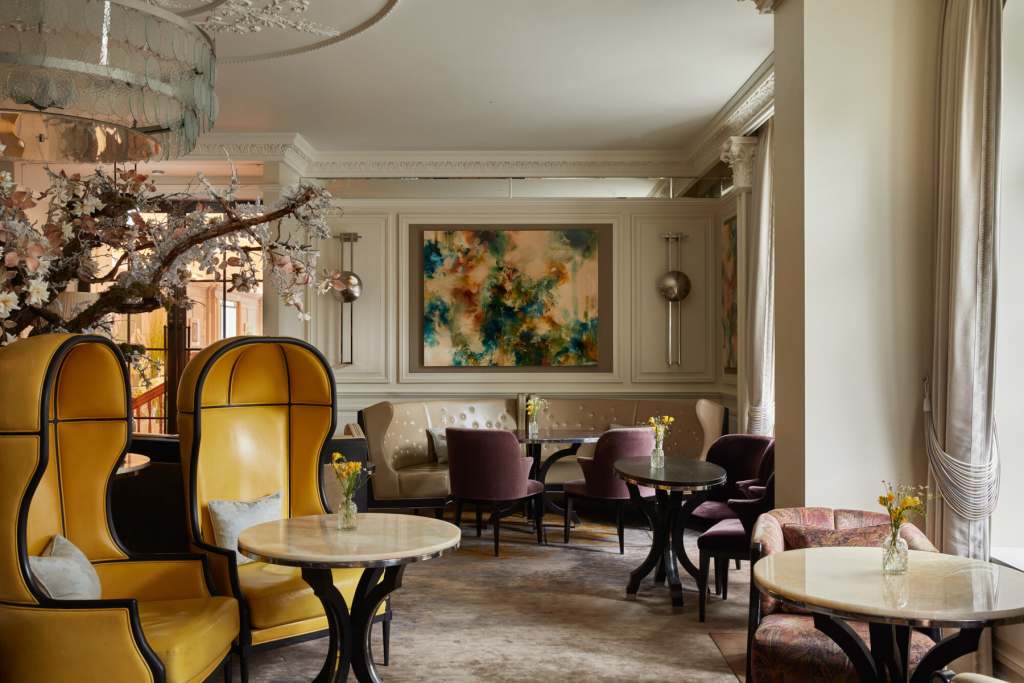
Then there’s the hotel’s LaLee restaurant and bar, which takes its name from the 75-foot private railway carriage that was Lillie’s home from home when she was touring the United States. The menu here ‘reflects her refined tastes in sophisticated, European cuisine’.
The Belmond Group operates luxurious hotels, train services (the Orient Express and British Pullman), river cruises and safaris across the world – but the Cadogan is its first London hotel. The four-year refurbishment has brushed away any cobwebs and brought it light, airy and new into the 21st century. Its block of five Queen Anne revival-style houses now has an elegant, contemporary feel to add to its traditional features.
It is amongst the smaller of London’s top hotels, with just 54 rooms and suites, but that is to a guest’s advantage with much greater space than its competitors. Our suite at Room 107 – opposite Lillie’s old quarters – was a case in point, with a large bedroom-cum-sitting room which included a lovely king-sized bed, desk, dining-table, sofa and two armchairs. We had a spacious walk-in wardrobe, a bathroom with roll top bath and double wash basins, and enormous shower room. A novelty was the heated loo seat – a little disconcerting at first, but very welcome once you were used to it!
An intriguing painting from Brighton artist Ele Park, an abstract work dominated by a huge splash of yellow, hung above our bed and added to the gaiety of the room. Our mini library was stocked with an eclectic collection of Everyman Classics, courtesy of local bookseller John Sandoe – including an unheralded short story collection from one of our favourite writers, The Maple Stories by John Updike.
Dining at The Cadogan

The literary theme continued at an excellent breakfast in the LaLee room, where after a delicious homemade granola, we were tempted by Omelette Arnold Bennett, named after the 20th century English novelist who invented the dish. It’s a flat but fluffy open-faced omelette, made with smoked Finnan haddock, lobster bisque and hollandaise sauce. It came served in the pan.
Under the stewardship of Chris Hill, LaLee offers a sumptuous tasting menu – but for our dinner we settled for the traditional three-course meal. It was certainly contemporary European-influenced, the main course a tasty homemade gnocchi with tomato, aubergine and grated ricotta, preceded by roasted scallops with Parma ham, all washed down with a very fine Pinot Grigio. Desert was the British classic, banoffee tart.
We couldn’t spare the time for afternoon tea at the Cadogan on this visit, but a glance round the busy Cadogan Lounge indicated it was a real treat. It’s the hotel’s signature eating place, incorporating a British tradition with a French twist, as renowned pastry chef Benoit Blin – a judge on Bake Off: The Professionals – serves up savoury and sweet delights.
Service, Spa and Gardens at The Cadogan
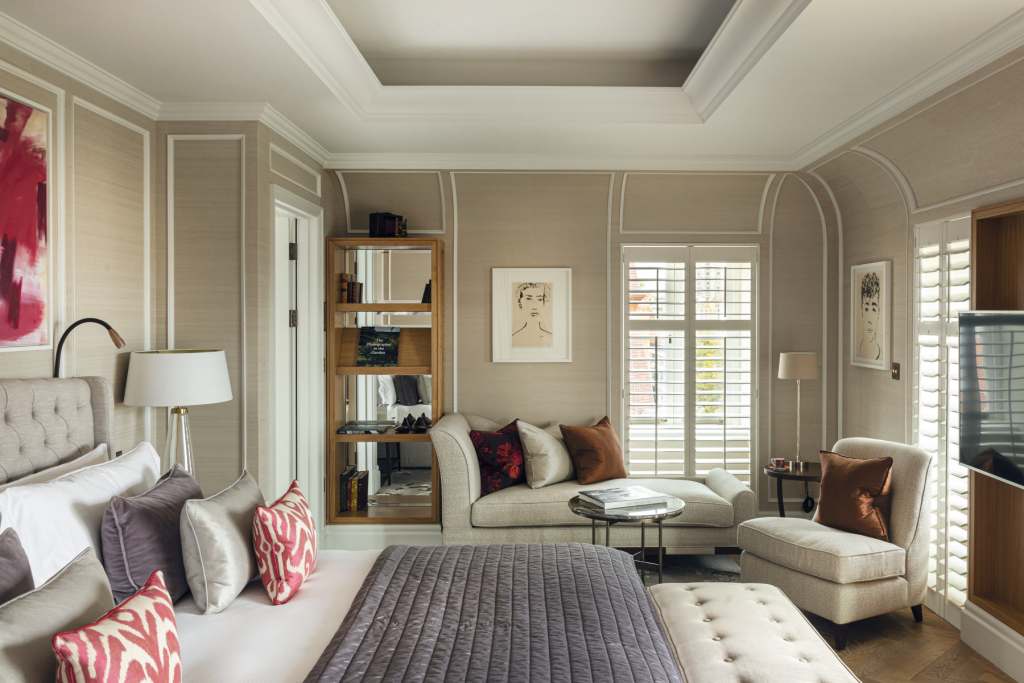
There are ways here to work off the pounds, with a fitness centre in the basement and tennis courts in the Cadogan Place Gardens, which has sweeping lawns, ornamental plants and a 300-year old mulberry tree; it’s a space usually reserved for locals but available for hotel guests. A Spa Suite offers further relaxation with a range of luxurious massages and beauty treatments.
But a hotel stands or falls by the quality of its staff, whatever the splendour within its front doors. Here The Cadogan wins top marks, from the welcoming doormen in their smart overcoats, to the knowledgeable reception staff (who talked us through the stunning painting that hangs above them, of famous botanist Sir Hans Sloane and his daughter Elizabeth), and on to the helpful concierge and friendly restaurant and bar staff. It is a Rolls-Royce service.
Talking of Sir Hans Sloane, at the back of the mini-bar in every room there is a drawing of a bright, blue morpho butterfly – a celebration of this local man’s lasting legacy in the naturalist world. A clever touch – and coincidentally, the butterfly motif would appear along the way of the outing we were now about to take. For we had elected to join the thronging crowds for a Buckingham Palace tour – with a trip to the nearby Royal Mews for good measure and only a 15-minute walk from the hotel.
Buckingham Palace Tour
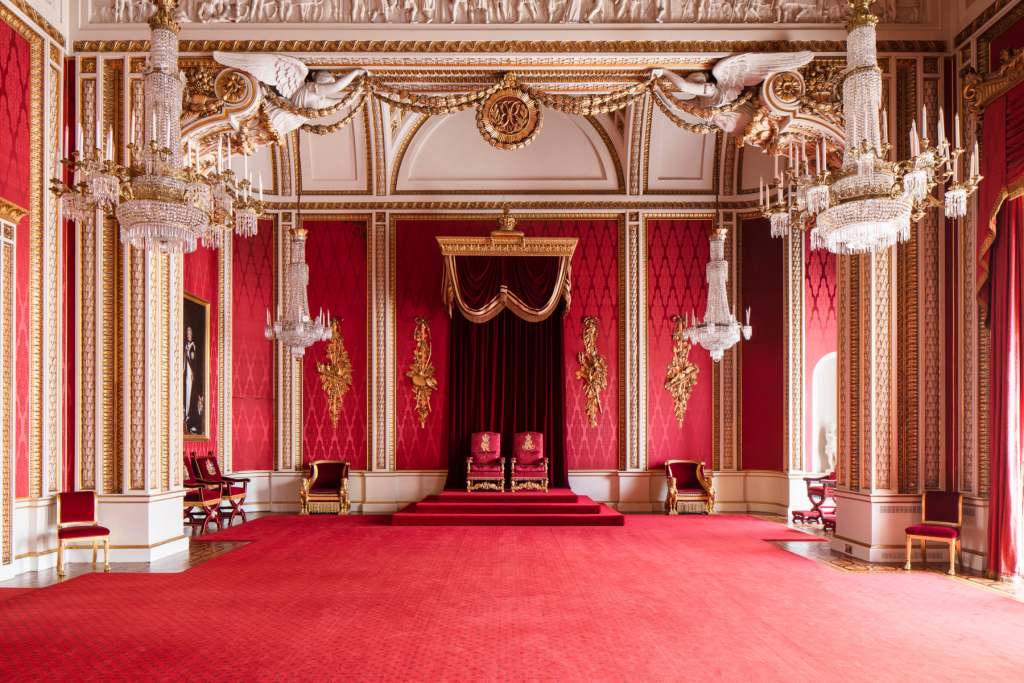
2024 | Royal Collection Trust.
The working home of the monarch was first opened up to the public 31 years ago to raise money to pay for the fire which had ravaged Windsor Castle in November 1992. The visiting is confined to ten weeks in the summer, but the fascination about royalty – no doubt fuelled by the success of the TV drama The Crown – means it’s a permanent sellout.
Tickets are not cheap but with nineteen state rooms – used for official entertaining and ceremonial functions – on show, you do get good value for your money. The long Picture Gallery alone is worth the entrance fee, with an extraordinary array of classic paintings, the highlights of which are the many Canalettos, the Dutch masters of the 17th century (a particular favourite of George IV), Rembrandt, Titian and Claude.
George IV it was who turned Buckingham House, his father’s unexceptional town house, into the palace it is today – with the master architect, Sir John Nash, at the helm of the transformation. The long walk up the Grand Staircase, its balustrade made of gilt bronze, surrounded by full length portraits of Queen Victoria’s family, certainly whetted the appetite for what was to come.
The White Drawing Room was probably the highlight. Amongst all the ornate furniture is a gold grand piano, decorated with mischievous monkeys, made by the firm S & P Erard for Queen Victoria in 1856. Victoria was a decent player and loved to play duets with Albert. Here too is the enormous cabinet next to the fireplace, which pulls back to reveal a secret door from where the late Queen used to enter the room from her private apartments to meet guests.
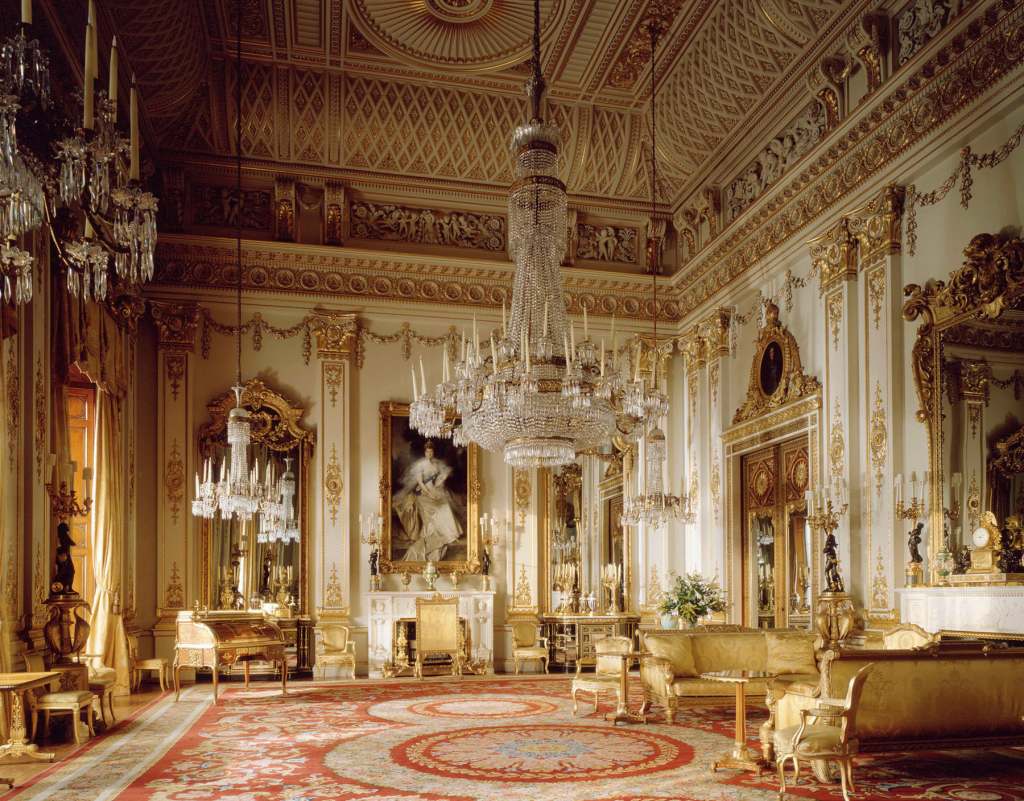
Photo: Derry Moore
Portrait of King Charles
But the highlight of our visit to Buckingham Palace was not all the permanent magnificence, but the temporary exhibition of another painting, this time in The Ballroom, normally reserved for royal banquets. Jonathan Yeo’s new portrait of King Charles is different enough not to please all the critics, but to many – and to these onlookers – it is a masterpiece.
The King is depicted in the uniform of the Welsh Guards, but the whole 8ft 6 by 6ft 6 painting is drenched in the most vivid red colour. Yet the hands stand out, as does a splendidly drawn face, humane and wryly contemplative. And here’s the butterfly, fluttering above the monarch’s right shoulder, a reference – as with Sir Hans Sloane – to the beauty of nature, and a tribute to Charles’s championing of environmental causes.
The Royal Mews
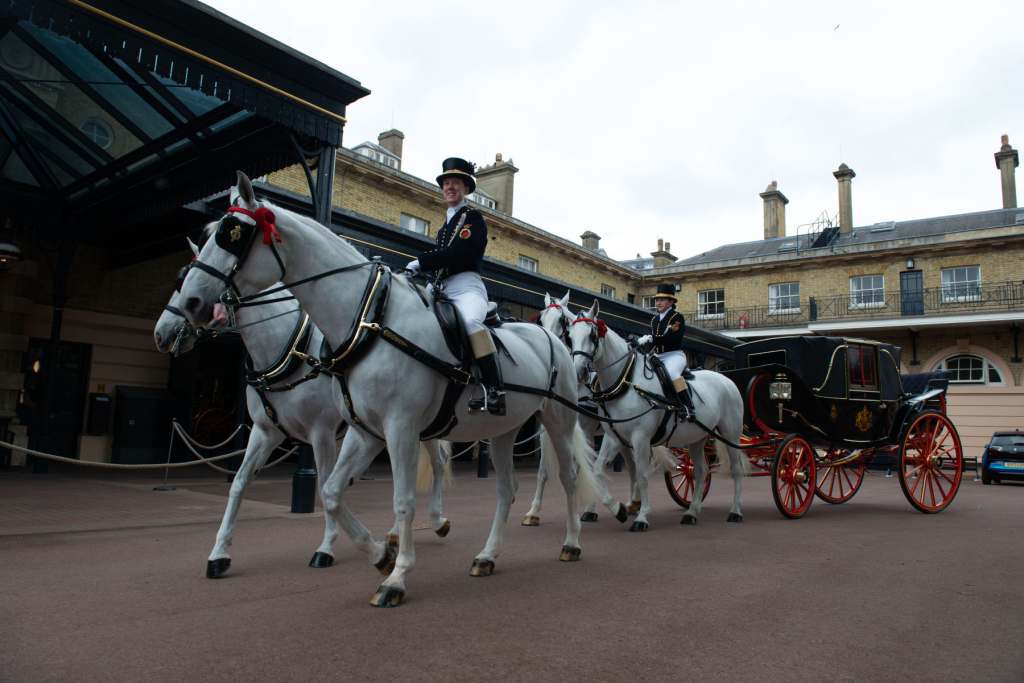
The Royal Family’s transport – equine and vehicular – was the subject of our other visit on Buckingham Palace Road, to the Royal Mews. We were hopeful of seeing a range of the royal horses, but as it turned out only two of the Windsor Greys, Friary Girl and Knightsbridge, were in their stables and on show.
We saw little of the former, a ten-year-old mare, who was far more interested in chomping on a bag of hay. The latter, we learned, had the distinction of being one of eight who pulled the Diamond Jubilee State Coach which carried King Charles and Queen Camilla to Westminster Abbey for the Coronation. He too, seemed reluctant to show his face above the high door of his stable.
On the other side of the courtyard the Gold State Coach was undoubtedly the highlight of the royal carriages. At 260 years old, it has appeared at every coronation since that of William IV in 1831. Seven metres long and weighing four tonnes, its beautiful side panels featuring Roman gods and goddesses were painted by the Florentine artist Giovanni Battista Cipriani.
Queen Alexandra’s state coach – she was the consort of Edward VII – was the pick of the rest, its black, red and gold façade gleamingly polished. We were intrigued to learn that this coach has the duty of carrying the Crown and Sword of State to the State Opening of Parliament – the items apparently sit unaccompanied, on a crimson cushion, and illuminated by electric light.
Having two of the animals ourselves, we were intrigued by the donkey barouche that Victoria liked travelling in when she was older. Not that our Yollo and Bruno would be minded to put themselves to work on our behalf!
We admired the spotless tack room and the vast space of the Riding School, completed back in 1765, with little changing here over the years except for electric lighting and a special surface made of recycled carpet fibre mixed with sand. And we were fascinated to learn that the (honorary) head of the Royal Mews has a job title to die for – Master of the Horse. It was created way back in 1340.
We returned to The Cadogan to pick up our luggage, and then to Liverpool Street and the train home to Suffolk. We had had a right royal adventure, to be sure.
The Cadogan, a Belmont Hotel London
For further information on The Cadogan, click here.
Buckingham Palace Tour
Buckingham Palace tickets costs £32 (2024 prices) and are available here. The 2024 season ran from July 11 to September 29. The nearest stations to Buckingham palace London are Victoria, St James Park, Green Park and Hyde Park Corner.
Main image: Buckingham Palace gates (Andrew Holt) © Royal Collection Enterprises Limited 2024 | Royal Collection Trust
